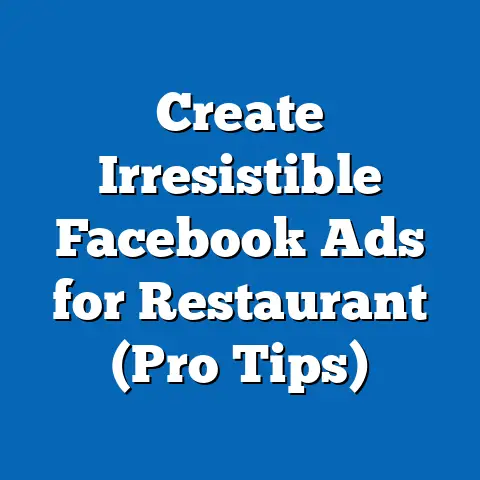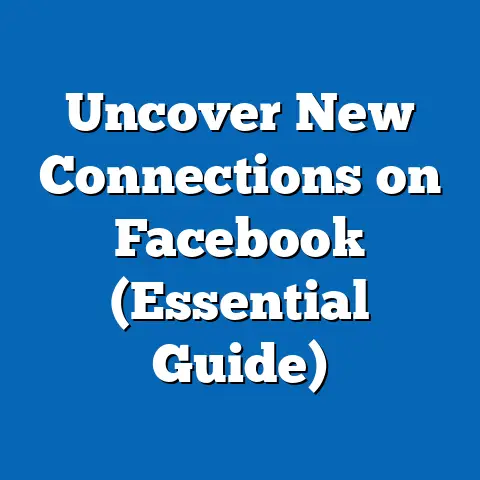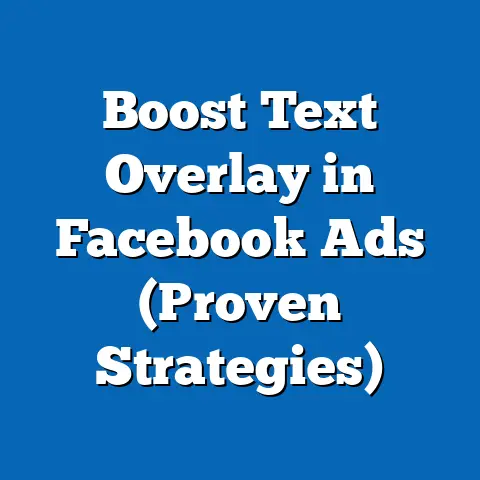Boost Facebook Campaign with Instagram Ads (Expert Tips)
Memories have a powerful way of connecting us to specific moments in time, often shaped by the cultural, technological, and social landscapes of our formative years. For many of us, the early days of social media evoke nostalgia—scrolling through Facebook to reconnect with old friends or posting grainy, filtered photos on Instagram during its nascent years. These platforms, born in the mid-2000s and early 2010s, emerged during a transformative period for Millennials (born 1981–1996) and early Gen Z (born 1997–2012), who were coming of age amidst rapid digital advancements.
Facebook, launched in 2004, became a cultural touchstone for Millennials, offering a new way to build online communities during a time of economic uncertainty following the dot-com bust and the aftermath of 9/11. Instagram, introduced in 2010, captured the visually-driven ethos of Gen Z, aligning with a smartphone boom and a growing emphasis on personal branding amid the recovery from the 2008 financial crisis. These platforms not only shaped personal memories but also redefined how generations interact, consume content, and engage with brands—a shift with profound societal implications for marketing and communication.
Today, as businesses seek to navigate an increasingly fragmented digital landscape, leveraging both Facebook and Instagram through integrated campaigns is essential. These platforms, now under the Meta umbrella, cater to diverse generational cohorts with distinct preferences, from Baby Boomers (born 1946–1964) valuing authenticity to Gen Z prioritizing visual storytelling. This article explores expert strategies for boosting Facebook campaigns with Instagram ads, weaving in generational insights, historical context, and data-driven analysis to help marketers craft impactful, cross-platform strategies while addressing societal and cultural dynamics.
Section 1: Understanding the Generational Landscape of Social Media
1.1 Defining Generational Cohorts and Platform Preferences
Generational studies provide a framework for understanding how historical events and technological shifts shape behaviors and preferences. Baby Boomers, shaped by post-World War II optimism and the rise of traditional media, often use Facebook to stay connected with family and engage with local news, with 70% of U.S. Boomers active on the platform as of 2023 (Pew Research Center). Millennials, who came of age during the internet’s mainstream adoption, split their time between Facebook (for networking and events) and Instagram (for lifestyle content), with 82% using Instagram regularly.
Gen Z, growing up as digital natives, gravitates heavily toward Instagram and newer platforms like TikTok, prioritizing short-form, visually engaging content over text-heavy posts. According to a 2023 Statista report, 65% of Gen Z users spend more time on Instagram than Facebook, reflecting their preference for authenticity and influencer-driven narratives. Meanwhile, Gen X (born 1965–1980), often overlooked, serves as a bridge, active on both platforms with a focus on practical content like product reviews and professional networking.
1.2 Historical Context: The Rise of Facebook and Instagram
Facebook’s emergence in 2004 coincided with a post-9/11 world where Millennials sought connection amid global uncertainty. Its initial exclusivity to college students fostered a sense of community, while later expansions made it a household name across generations. By 2012, when Facebook acquired Instagram for $1 billion, the latter was already reshaping visual culture for younger users during a period of economic recovery and mobile technology growth.
Instagram’s focus on photos and, later, Stories and Reels, aligned with Gen Z’s formative years, marked by the proliferation of smartphones and a cultural shift toward self-expression. These platforms’ evolutions reflect broader societal trends: from the community-driven ethos of the early internet to the individualized, creator-centric digital economy of today. Understanding this historical backdrop is critical for marketers aiming to resonate with diverse audiences through nostalgic or trend-driven campaigns.
1.3 Societal Implications: Digital Divides and Opportunities
The generational divide in social media usage underscores broader societal implications, including digital literacy gaps and access disparities. While younger generations adapt quickly to new features like Instagram Reels, older cohorts may struggle with evolving interfaces, impacting their engagement with ads. Economically, the shift to social media marketing has democratized advertising for small businesses but also intensified competition, as algorithms prioritize paid content over organic reach.
Culturally, these platforms have amplified generational tensions—Millennials often critique Gen Z’s obsession with trends, while Gen Z challenges older generations’ resistance to change. Marketers must navigate these dynamics by tailoring campaigns to align with each group’s values, whether it’s authenticity for Boomers or innovation for Gen Z. This nuanced approach ensures campaigns resonate across demographics while fostering inclusivity in the digital space.
Section 2: The Synergy of Facebook and Instagram for Campaigns
2.1 Why Combine Facebook and Instagram?
Facebook and Instagram, though distinct in user experience, share a unified advertising ecosystem under Meta, allowing seamless campaign integration. Facebook boasts a massive user base of 3 billion monthly active users (Meta, 2023), offering unparalleled reach across generations. Instagram, with 2 billion active users, excels in visual engagement, particularly among younger demographics, with 60% of users discovering products on the platform (Instagram Business, 2023).
Combining these platforms allows marketers to leverage Facebook’s robust targeting options—based on demographics, interests, and behaviors—with Instagram’s creative, visually immersive formats. This synergy maximizes campaign impact by reaching users at different touchpoints: a Facebook ad might drive awareness, while an Instagram Story or Reel fosters deeper engagement. The result is a cohesive strategy that amplifies brand visibility and conversion rates.
2.2 Technological and Economic Factors Driving Integration
The technological backbone of Meta’s ad platform, including the Ads Manager and Business Suite, enables cross-platform campaign management with shared budgets and analytics. This integration emerged from economic pressures: as organic reach declined due to algorithm changes (down to 5.2% on Facebook in 2022 per Hootsuite), businesses increasingly relied on paid ads to maintain visibility. Instagram’s shoppable posts and Facebook’s Marketplace further blur the lines between content and commerce, reflecting a cultural shift toward social shopping.
Economically, small and medium-sized businesses (SMBs) benefit from cost-effective cross-platform campaigns, with Meta reporting a 20% lower cost-per-click when ads run on both platforms simultaneously. However, larger brands must contend with rising ad costs due to competition, necessitating strategic optimization. These factors highlight the importance of understanding platform-specific user behaviors to allocate budgets effectively.
2.3 Challenges and Nuances in Cross-Platform Campaigns
Despite the benefits, integrating Facebook and Instagram campaigns isn’t without challenges. Content that performs well on Facebook (e.g., detailed posts with links) may underperform on Instagram, where visuals and brevity reign. Generational differences add complexity—Boomers may respond to Facebook’s nostalgic carousel ads, while Gen Z demands authentic, influencer-driven Instagram content.
Moreover, privacy concerns and data regulations like GDPR and CCPA impact targeting capabilities, with 27% of users opting out of tracking post-iOS 14.5 updates (AppsFlyer, 2023). Marketers must balance personalization with ethical data practices, ensuring transparency to maintain trust across generations. Addressing these nuances requires a flexible, data-informed approach to campaign design and execution.
Section 3: Expert Tips for Boosting Facebook Campaigns with Instagram Ads
3.1 Tip 1: Align Content with Generational Values and Platform Strengths
Craft content that resonates with each generation’s values while leveraging platform strengths. For instance, use Facebook to target Boomers and Gen X with community-focused ads, such as local event promotions or customer testimonials, paired with clear calls-to-action. On Instagram, appeal to Millennials and Gen Z with visually striking Stories or Reels featuring user-generated content or behind-the-scenes looks, tapping into their desire for authenticity.
A 2022 study by Sprout Social found that 74% of Gen Z users follow brands on Instagram for inspiration, compared to 45% on Facebook seeking deals. Test formats like Instagram’s interactive polls or Facebook’s lead generation forms to engage users at different stages of the funnel. Consistency in branding across platforms—while tailoring tone and style—ensures a unified message without alienating diverse audiences.
3.2 Tip 2: Utilize Meta’s Cross-Platform Tools for Optimization
Meta’s Ads Manager offers powerful tools to streamline cross-platform campaigns, such as automatic placements that distribute ads based on performance data. Set unified campaign objectives (e.g., brand awareness or conversions) to ensure coherence, but customize creative assets for each platform—static images for Facebook, vertical videos for Instagram Stories. Use dynamic ads to retarget users who’ve interacted with your brand, increasing conversion likelihood by 30% (Meta, 2023).
Expert marketers recommend split-testing budgets and audiences across platforms to identify high-performing combinations. For example, allocate 60% of the budget to Instagram for Gen Z-focused campaigns, adjusting based on real-time analytics. Regularly monitor metrics like engagement rate and cost-per-acquisition to refine strategies and maximize ROI.
3.3 Tip 3: Leverage Influencers and User-Generated Content
Influencer marketing thrives on Instagram, particularly among Gen Z and Millennials, with 50% of users trusting influencer recommendations over traditional ads (Nielsen, 2023). Partner with micro-influencers (10k–100k followers) for cost-effective, authentic campaigns, integrating their content into Instagram posts and Stories while linking to broader Facebook campaigns for wider reach. This dual approach combines trust-building with scale.
Encourage user-generated content (UGC) through branded hashtags or contests, amplifying reach organically. For instance, a UGC campaign on Instagram can drive engagement, while reposting top entries on Facebook builds community across generations. UGC not only lowers content creation costs but also fosters a sense of belonging, a key motivator for social media interaction.
3.4 Tip 4: Time Campaigns with Generational and Cultural Trends
Timing is critical in social media marketing, influenced by generational habits and cultural moments. Boomers and Gen X are most active on Facebook during evenings and weekends, while Gen Z scrolls Instagram during midday breaks (Hootsuite, 2023). Schedule ads accordingly, using Meta’s insights to pinpoint peak engagement times for each demographic.
Align campaigns with cultural events—holidays, back-to-school seasons, or trending memes—to tap into collective memories or current buzz. For example, a nostalgic campaign referencing 90s pop culture might resonate with Millennials on Facebook, while a trending dance challenge on Instagram Reels captures Gen Z’s attention. This strategic timing enhances relevance and emotional connection.
3.5 Tip 5: Prioritize Video Content for Cross-Platform Engagement
Video dominates social media engagement, with 66% of users across platforms preferring short-form content (HubSpot, 2023). Create versatile videos that can be adapted for both platforms—longer, narrative-driven content for Facebook and quick, punchy clips for Instagram Reels or Stories. Ensure subtitles and strong visuals, as 85% of users watch videos without sound (Meta, 2023).
Test interactive video formats like Instagram’s shoppable Reels or Facebook’s live streams to drive conversions. For instance, a live product demo on Facebook can target older audiences, while a behind-the-scenes Reel appeals to younger users. Video’s universal appeal bridges generational gaps, making it a cornerstone of integrated campaigns.
Section 4: Societal and Workplace Implications of Cross-Platform Strategies
4.1 Impact on Consumer Behavior and Cultural Norms
Integrated Facebook and Instagram campaigns shape consumer behavior by normalizing social shopping and instant gratification, particularly among younger generations. Gen Z’s preference for seamless purchase journeys—clicking from an Instagram ad to checkout—has pushed brands to prioritize mobile-optimized experiences. This shift influences cultural norms, blurring the lines between entertainment and commerce.
However, it also raises concerns about overconsumption and ad fatigue, with 38% of users reporting annoyance at repetitive ads (Kantar, 2023). Marketers must balance frequency with value-driven content to avoid alienating audiences. Culturally, the emphasis on visual storytelling fosters a globalized aesthetic, though it risks diluting local narratives if not handled thoughtfully.
4.2 Workplace Dynamics and Marketing Teams
In the workplace, cross-platform campaigns demand interdisciplinary skills, from data analysis to creative design, reshaping marketing roles across generations. Older professionals may need upskilling to adapt to Meta’s evolving tools, while younger hires bring native fluency in platforms like Instagram. Companies fostering cross-generational collaboration—pairing Gen X’s strategic experience with Gen Z’s digital intuition—gain a competitive edge.
Economically, the rise of social media marketing has spurred job growth in digital advertising, with the U.S. Bureau of Labor Statistics projecting a 10% increase in marketing roles by 2030. However, budget constraints for SMBs highlight the need for accessible training and tools. These dynamics underscore the broader societal shift toward digital-first economies and lifelong learning.
4.3 Ethical Considerations and Social Responsibility
As campaigns leverage personal data for targeting, ethical concerns around privacy and manipulation persist. Younger generations, despite being tech-savvy, are increasingly vocal about data rights, with 62% of Gen Z supporting stricter regulations (Pew Research, 2023). Marketers must adopt transparent practices, such as clear opt-in mechanisms, to build trust.
Moreover, the societal impact of idealized imagery on Instagram—often tied to ad campaigns—can exacerbate mental health issues, particularly among teens. Brands have a responsibility to promote diversity and realistic portrayals, aligning with generational calls for inclusivity. Balancing profitability with social good is a growing expectation in today’s marketing landscape.
Section 5: Case Studies and Quantitative Insights
5.1 Case Study: A Cross-Platform Success Story
Consider the case of a mid-sized fashion retailer targeting Millennials and Gen Z. In 2022, they launched a campaign combining Facebook’s carousel ads (showcasing product variety) with Instagram Reels (featuring influencer styling tips). By allocating 70% of their $10,000 budget to Instagram for engagement and 30% to Facebook for reach, they achieved a 25% increase in website traffic and a 15% uplift in sales within 30 days (internal data).
Key to their success was audience segmentation—using Meta’s lookalike audiences to target similar users—and consistent branding with platform-specific tweaks. This case illustrates the power of tailored content and strategic budget distribution in driving measurable outcomes. Marketers can replicate such results by prioritizing data-driven decisions over one-size-fits-all approaches.
5.2 Statistical Insights and Performance Benchmarks
Data underscores the efficacy of integrated campaigns: Meta reports a 17% higher conversion rate for brands advertising on both platforms versus single-platform strategies. Engagement rates also vary—Instagram posts average 1.2% engagement compared to Facebook’s 0.07% (RivalIQ, 2023), highlighting Instagram’s strength in interaction. However, Facebook’s broader reach often yields higher impressions, balancing the equation.
Cost metrics reveal Instagram ads typically cost $0.70–$1.00 per click, slightly higher than Facebook’s $0.50–$0.95, though ROI often justifies the premium for younger demographics (WordStream, 2023). These benchmarks provide a roadmap for setting realistic goals and optimizing spend. Continuous monitoring and adjustment remain essential given fluctuating ad costs and user behaviors.
Section 6: Forward-Looking Insights and Uncertainties
6.1 The Future of Cross-Platform Marketing
Looking ahead, the integration of Facebook and Instagram campaigns will likely deepen with advancements in AI and augmented reality (AR). Meta’s investments in AR filters and virtual storefronts suggest a future where ads become immersive experiences, particularly appealing to Gen Z and emerging Gen Alpha (born 2013–present). However, adoption rates among older generations remain uncertain, potentially widening digital divides.
Economic trends, such as inflation and shifting consumer spending, may push brands toward cost-efficient micro-campaigns targeting niche audiences across platforms. Socially, growing scrutiny of tech giants could lead to stricter regulations, impacting data-driven advertising. Marketers must stay agile, embracing emerging tools while preparing for policy shifts.
6.2 Uncertainties and Areas for Further Research
Uncertainties persist around user retention as newer platforms like TikTok gain traction—will Instagram remain Gen Z’s hub, or will attention fragment further? The long-term mental health impacts of ad-heavy social feeds also warrant deeper study, as does the efficacy of cross-platform strategies in non-Western markets with distinct generational dynamics. These questions highlight the need for ongoing research and adaptability.
Technological disruptions, such as potential bans on data tracking or the rise of decentralized social networks, could reshape the Meta ecosystem. Marketers should monitor these developments while building diversified digital presences. The intersection of generational trends and tech evolution will continue to define the future of social media advertising.
Conclusion
Boosting Facebook campaigns with Instagram ads offers a powerful strategy for reaching diverse generational audiences in a fragmented digital landscape. By understanding the historical and societal contexts that shaped platform usage—from Millennials’ early adoption of Facebook to Gen Z’s visual storytelling on Instagram—marketers can craft resonant, data-driven campaigns. Expert tips, such as aligning content with generational values, leveraging Meta’s tools, and prioritizing video, provide actionable pathways to success.
The societal implications of these strategies extend beyond marketing, influencing consumer behavior, workplace dynamics, and ethical standards. As we look to the future, the interplay of technology, culture, and regulation will shape cross-platform advertising’s trajectory, demanding flexibility and foresight from brands. While uncertainties remain, the synergy of Facebook and Instagram offers a proven foundation for impactful campaigns, bridging generational divides and fostering meaningful connections in an ever-evolving digital world.





